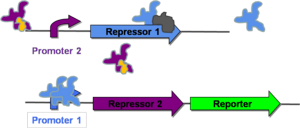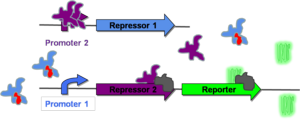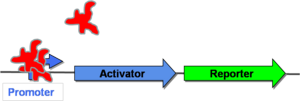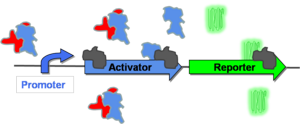|
|
| Line 9: |
Line 9: |
| | [[Image:Offstate.png|thumb|300px|right|'''Figure 1:''' Depiction of a mutual repression system in the "off" state.]] | | [[Image:Offstate.png|thumb|300px|right|'''Figure 1:''' Depiction of a mutual repression system in the "off" state.]] |
| | [[Image:Rep2 Bound.png|thumb|300px|right|'''Figure 2:''' Depiction of a mutual repression system in the "on" state.]] | | [[Image:Rep2 Bound.png|thumb|300px|right|'''Figure 2:''' Depiction of a mutual repression system in the "on" state.]] |
| − | | + | The mutual repression model can fuction as a genetic toggle switch, capable moving between two stable states. This system was first implemented in ''E. coli'' in 2000 and will be the focus of the first paper discussed (Gardner, 2000). Mutual repression relies on the use of two constitutive promotors that regulate the transcription of repressor genes. As can be seen on the right, both promoters are placed upstream of the repressor pair for the opposite promoter. When a given promoter is active, it shuts down transcription of its repressor pair by transcribing a repressor gene for the opposite promoter. This allows the cell to remain in one of two stable states. Figure 1 shows a system in which Promoter 2 is initially active. This state arises because of the presence of an inactivator molecule of Repressor 2 (shown in orange). The inactivator molecule binds to any Repressor 2 in the cell, allowing for transcription of Repressor 1. (The gray molecule represents RNA Polymerase.) Repressor 1 then binds to Promoter 1 and represses any further transcription of Repressor 2. At this point, the cell is in a stable state, where Repressor 2 is expressed and Repressor 1 is not. |
| − | Put text here.
| |
| − | | |
| | [[Image:linebreak.png]] | | [[Image:linebreak.png]] |
| | | | |
Revision as of 18:10, 16 November 2007
Error creating thumbnail: Unable to save thumbnail to destination
Biological Models
Overview
Thus far in the construction of various synthetic cellular memory devices, two main biological models have been used by researchers: mutual repression and autoregulatory positive feedback. Both of these models produce two stable levels at which a reporter protein can exist in a given cell. Based on a given input, both models balance reporter protein concentrations to one of these two stable states (typically "on" or "off"), determined by the configuration of genes and promoters in the system. Both the mutual repression model and the autoregulatory positive feedback model are found in natural systems, but each equips a synthetic device with different capabilities. The mutual repression model works by turning off expression of one or more constitutively expressed genes based on an input, while autoregulatory positive feedback turns on one or more constitutively repressed genes based on an input.
Mutual Repression
 Figure 1: Depiction of a mutual repression system in the "off" state.  Figure 2: Depiction of a mutual repression system in the "on" state. The mutual repression model can fuction as a genetic toggle switch, capable moving between two stable states. This system was first implemented in E. coli in 2000 and will be the focus of the first paper discussed (Gardner, 2000). Mutual repression relies on the use of two constitutive promotors that regulate the transcription of repressor genes. As can be seen on the right, both promoters are placed upstream of the repressor pair for the opposite promoter. When a given promoter is active, it shuts down transcription of its repressor pair by transcribing a repressor gene for the opposite promoter. This allows the cell to remain in one of two stable states. Figure 1 shows a system in which Promoter 2 is initially active. This state arises because of the presence of an inactivator molecule of Repressor 2 (shown in orange). The inactivator molecule binds to any Repressor 2 in the cell, allowing for transcription of Repressor 1. (The gray molecule represents RNA Polymerase.) Repressor 1 then binds to Promoter 1 and represses any further transcription of Repressor 2. At this point, the cell is in a stable state, where Repressor 2 is expressed and Repressor 1 is not.
Error creating thumbnail: Unable to save thumbnail to destination
Autoregulatory Positive Feedback
 Figure 3: Depiction of a autoregulatory positive feedback system in the "off" state.  Figure 4: Depiction of a autoregulatory positive feedback system in the "on" state. Put text here.
Error creating thumbnail: Unable to save thumbnail to destination
<Previous Section | Next Section>
|



